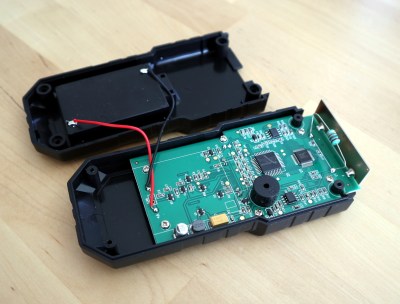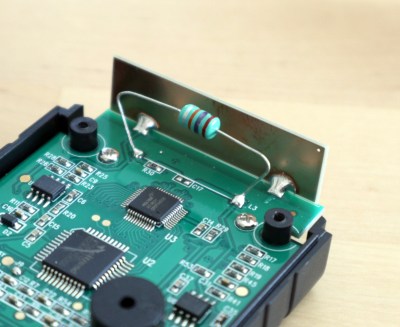Review: What On Earth Is An Electromagnetic Radiation Tester And Why Would I Need One?

One of the joys of an itinerant existence comes in periodically being reunited with the fruits of various orders that were sent to hackerspaces or friends somewhere along the way. These anonymous parcels from afar hold an assortment of wonders, with the added element of anticipation that comes from forgetting exactly what had been ordered.
So it is with today’s subject, a Mustool MT525 electromagnetic radiation tester. At a cost not far above £10 ($13.70), this was an impulse purchase driven by curiosity; these devices claim to measure both magnetic and electric fields, but what do they really measure? My interest in these matters lies in the direction of radio, but I have never examined such an instrument. Time to subject it to the Hackaday treatment.
Who Knew Everything Was So Harmful!
Out of the box comes a smart handheld unit with three buttons and an LCD display, and an instruction leaflet. On the rear of the case is a battery compartment, this takes three AAA cells. It claims to measure electric fields from 1 V/m to 1999 V/m, and magnetic fields from 0.01 μT to 99.99 μT, with a bandwidth from 5 Hz to 3500 MHz. Opening the instruction leaflet it becomes clear that this is intended for use in monitoring electromagnetic fields for the purpose of human safety, with a list of conditions from leukemia to blindness that they can cause.

Powering it up gives a zero reading for both measurements when held in free space in this very average house, increasing markedly when held near various electronic appliances. Particularly concerning is a beeper that sounds when either level is considered harmful, which it does in proximity to a horrifying number of items including the laptop keyboard and trackpad this is being written with. As expected the door seal of a running microwave oven generates particularly high readings, as does a Baofeng handheld transceiver at full power in the 430 MHz band. Sadly my CRT TV is in storage at the moment, but I would expect that would also generate high readings.

The alarm threshold values for that beeper are 40 V/m and 0.4 μT respectively, and given that it sounds the alarm on such mundane things as my keyboard I have to question what that means. Reading around the subject of typical safe exposure levels it becomes obvious that the alarm is set far too low, and I have to wonder whether it might cause unnecessary worry in a person who had bought this unit because of a personal concern for electromagnetic field levels. Fortunately the beep can be disabled with a long press of a button.
So having described what it does, what’s inside the case? On the back are four small screws, and with those undone it splits into two to reveal a circuit board. At the business end of the unit are the sensors, a metal plate for electric fields and a wire-ended inductor for magnetic ones, and their outputs are each fed to their own TI TLC27M2 dual op-amp. These in turn feed a Weltrend WT56F216 microcontroller which boasts an 8052 core and analogue inputs, that drives the LCD via a Holtek HT1621 LCD controller. It appears well-engineered, and the sensors follow what I would expect for a device measuring these properties.
Does It Have A Use?
The Mustool MT525 electromagnetic radiation tester then. It appears to be a well-engineered instrument that does what it claims, and measures the presence and strength of oscillating electric and magnetic fields. But is it an instrument that’s any use, should I trust it, and does it have a space on my bench? I am curious about its calibration for a start, it’s hardly as though I’d expect any traceable calibration certificate from such a cheap item, but are the V/m and μT figures even in the right ballpark? I am also concerned about the way it and devices like it are sold for health purposes, it worries me that there might be people driven to unnecessary worry by its “Harmful” beeper when in reality they have no need. For myself, I can report that it’s a handy way to check for a field at close quarters, and it works at common amateur radio frequencies, though I can’t really claim it has much use as a bench instrument. There is one thing at which it’s quite handy though, it detects live mains cables buried in walls more reliably than the traditional metal-detector type of wire finder, perhaps that’s where I will use it. For yourselves though, I bought one so you don’t have to.
Post a Comment